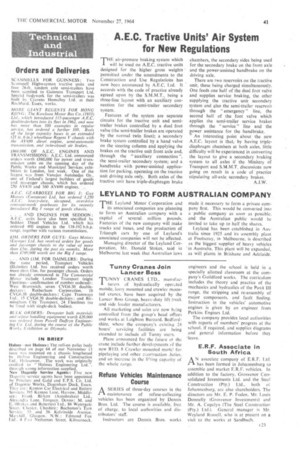A.E.C.Tractive Units' Air System for New Regulations
Page 43

If you've noticed an error in this article please click here to report it so we can fix it.
THE air-pressure braking system which will be used on A.E.C. tractive units designed for the higher gross weights . permitted under the amendments to the Construction and Use Regulations has now been announced by A.E.C. Ltd. It accords with the code of practice already agreed upon by the S.M.M.T., being a three-line layout with an auxiliary connection for the semi-trailer secondary system.
Features of the system are separate circuits for the tractive unit and semitrailer brakes controlled by a dual foot valve (the semi4railer brakes are operated by the normal twin lines); a secondary brake system controlled by a hand valve on the steering column and applying the brakes on the tractive unit front axle and, through the "auxiliary connection", the semi-trailer secondary system; and a handbrake with power-assisted application for parking, operating on the tractive unit driving axle only. Both axles of the tractive unit have triple-diaphragm brake
chambers, the secondary sides being used for the secondary brake on the front axle and the power-assisted handbrake on the driving axle.
There are two reservoirs on the tractive unit, these being charged simultaneously. One feeds one half of the dual foot valve and supplies service braking, the other supplying the tractive unit secondary system and also the semi-trailer reservoir through the " emergency " line, the second half of the foot valve which applies the semi-trailer service brakes through the "service" line and the gower assistance for the handbrake. An interesting point about the new A.E.C. layout is that, by having triplediaphragm chambers at both axles, little difficulty will he experienced in converting the layout to give a secondary braking system to all axles if the Ministry of Transport and S.M.M.T, discussions now going on result in a code of practice stipulating all-axle secondary brakes.
















































































































